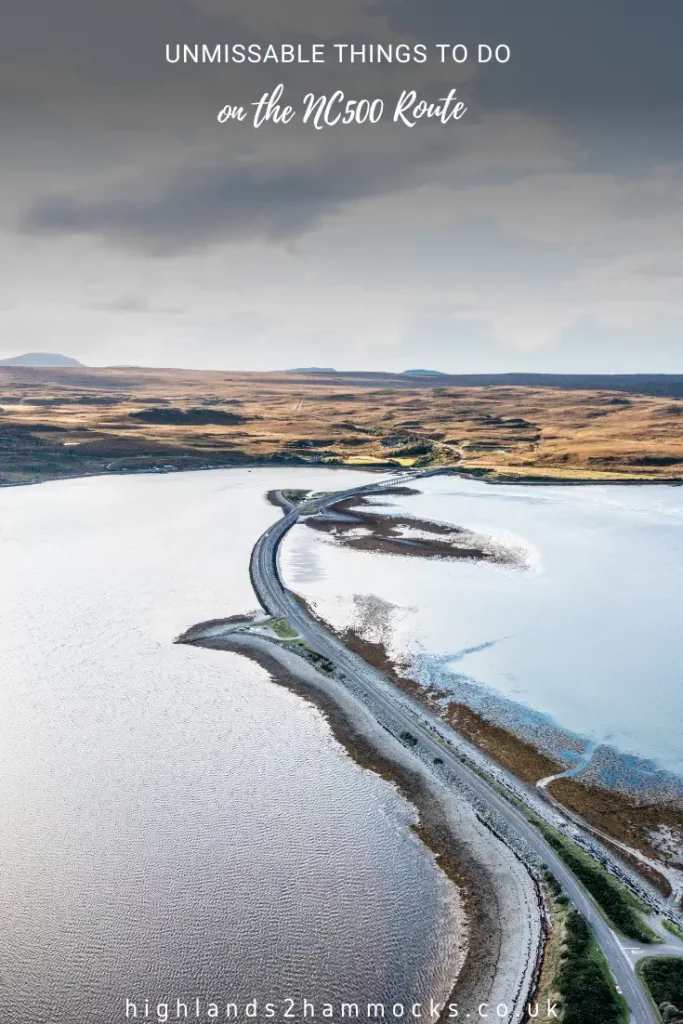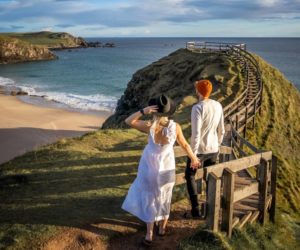The North Coast 500 is Scotland’s most well known road trip, showcasing the beauty of the Scottish beaches and mountains all on the one road trip. 500 miles of epic coastlines, stunning beaches, endless horizons and beautiful wildlife are what awaits you along the north coast of Scotland. Get planning your trip of a lifetime with this guide and witness some the most beautiful scenery in the world for yourself.
No time to read now? No problem, save a pin to your Pinterest board for later!
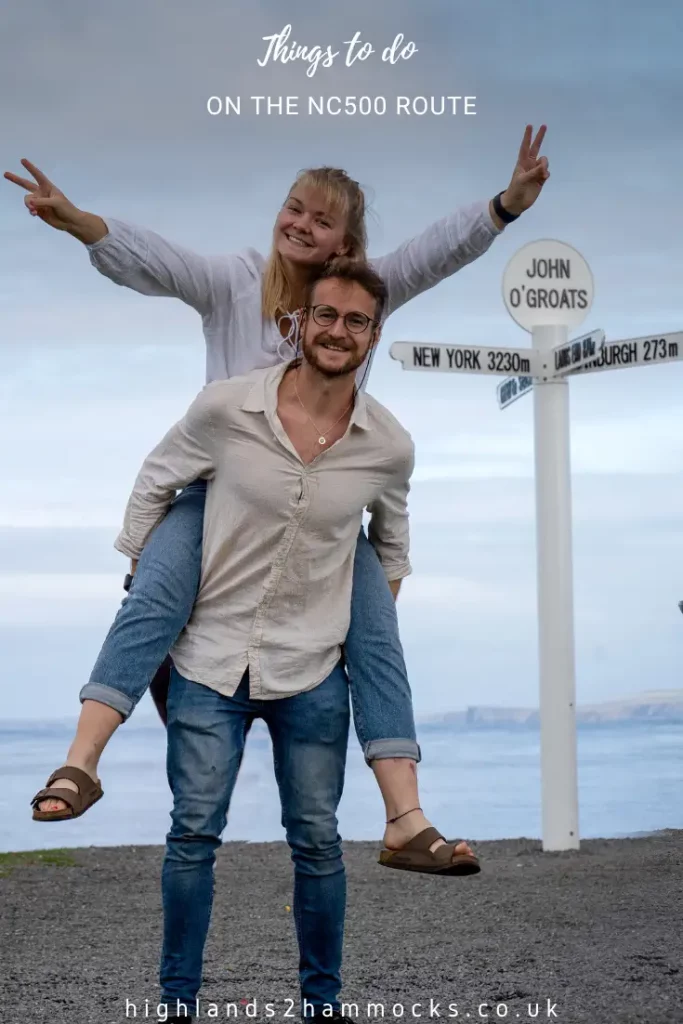

Unmissable Things to do on the NC500 Route
The North Coast 500 is the world-famous road trip stretching along the northern coast of the Scottish mainland. Officially launched in 2015, this 516-mile route has seen 30,000 new visitors head to the northern wilderness of Scotland, boosting the economy by more than £9million.
The official starting point of the NC500 is the northern capital of Inverness, which also happens to be the finishing point of this circular road trip. The best part of this route, however, is that you can start and finish it wherever you please, taking as long or as little time as you like on your trip.
In this guide, we will discuss the best time to go to on a NC500 road trip as well as the following
Table of Contents
Planning Your Trip
We use the below booking platforms to plan our trips. We hope you find them useful too!
NC500 Motorhome and Campervan Scheme
The NC500 Motorhome Scheme, officially known as the Highland Campervan and Motorhome Scheme, was launched by the Highland Council on July 1, 2024. This innovative initiative is designed to address the growing number of motorhomes and campervans traveling along the popular North Coast 500 (NC500) route, ensuring that their impact on the local environment and communities is managed sustainably.
The scheme offers a voluntary seven-day pass costing £40, inclusive of VAT. This pass grants motorhome and campervan users access to 12 designated overnight parking locations along the NC500 route, including scenic spots like Torvean Car Park in Inverness, Nairn Harbour, Dunnet Head Car Park, and Ullapool Latheron Car Park.
These parking spots are available on a first-come, first-served basis from 10 PM to 8 AM, with a 72-hour no-return policy at each location. This ensures that the facilities are used responsibly and that a larger number of travellers can benefit from them.
Overall, the NC500 Motorhome Scheme provides a structured and sustainable approach to motorhome travel in one of Scotland’s most scenic and popular areas. We think this is a great idea and encourage everyone to take advantage of it if you are looking to explore this road trip soon.
Read all about this new scheme in our complete guide to the NC500 Motorhome Scheme here.
For more information or to purchase a membership, travellers can visit the Highland Council’s official website.
Enjoy the Falls of Shin
Heading north from Inverness, the next stopping point is the glorious Falls of Shin. To get here you can either cross the Dornoch Firth Bridge and turn west or simply follow the southern coast of the Dornoch Firth towards Invershin. The Falls themselves are easy to find, with lots of signposts leading to the car park.
The Falls of Shin is a small collection of cascading steps of waterfalls, rising about 15m from bottom to top and stretched over about 300m of the river. The main spectacle at this sight is the natural phenomenon of the leaping salmon, an annual display of the resilience and power of nature.
If you visit here during the summer, there is a possibility of seeing these migratory salmon in action, leaping metres into the air to ascend the falls. This migration takes place as the salmon return from the sea and begins to travel inland to mate and lay eggs. This is the first time we have seen this and it is a spectacular sight!
In order to get to the waterfalls, head down the hill from the car park, across the road, and you will find the waterfall at the bottom of the stairs. Unfortunately, the viewing platform is not accessible for wheelchairs. By the car park, there is a restaurant and cafe that is perfect to rest and grab a coffee before you set off again to the next stop.
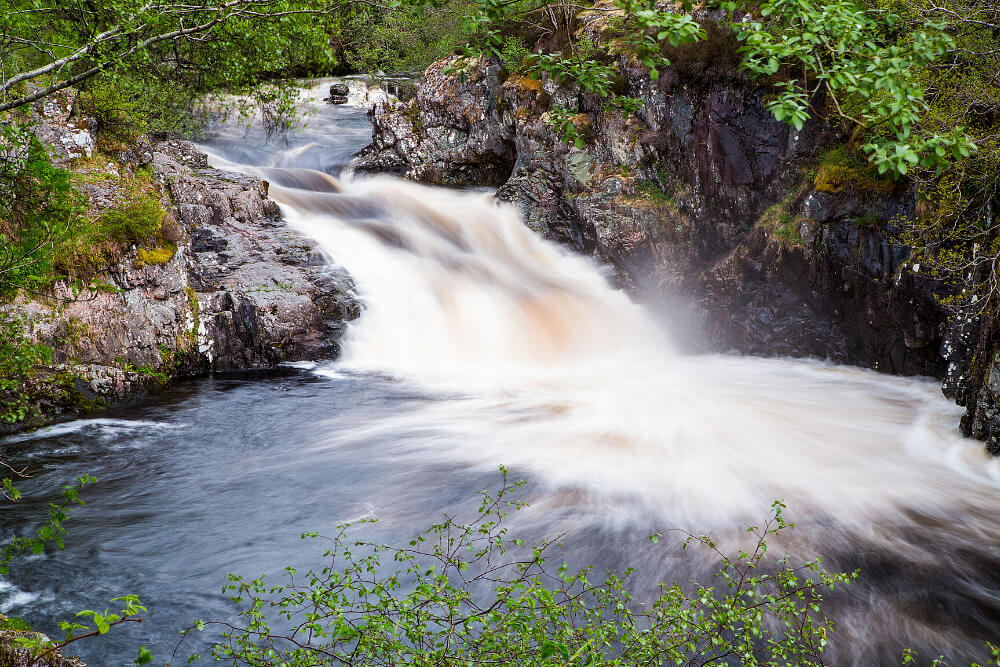
Witness the wonderful Duncansby Stacks
Marvel the incredible Duncansby Stacks that sit just outside of John O’Groats.
These towering sea stacks are believed to have stood in this position for the last 6000 years, slowly eroding away due to the raw power of the North Sea. The water in this part of Scotland has proven itself treacherous over the years, which has resulted in the construction of the nearby Duncansby Lighthouse.
Built in 1924, this lighthouse remained home to a keeper for over 70 years, until in 1997, it was fully automated and no longer required a resident. Soon after this automation, the keeper’s housing quarters showed signs of dampness and asbestos and were subsequently removed. The lighthouse tower remains here to this day, still functional and protecting boats from the crags and cliffs of this destructive span of water.
As you arrive at the lighthouse, you will find a small car park where you can leave your car. From here, walk over the hill to your right and the incredible towers of rock will come into view. These colossal monuments to time are a fantastic photo opportunity and, if the weather is okay, are the perfect spot for some light reflection of your trip so far.
Read our full guide to this incredible part of the country over here.
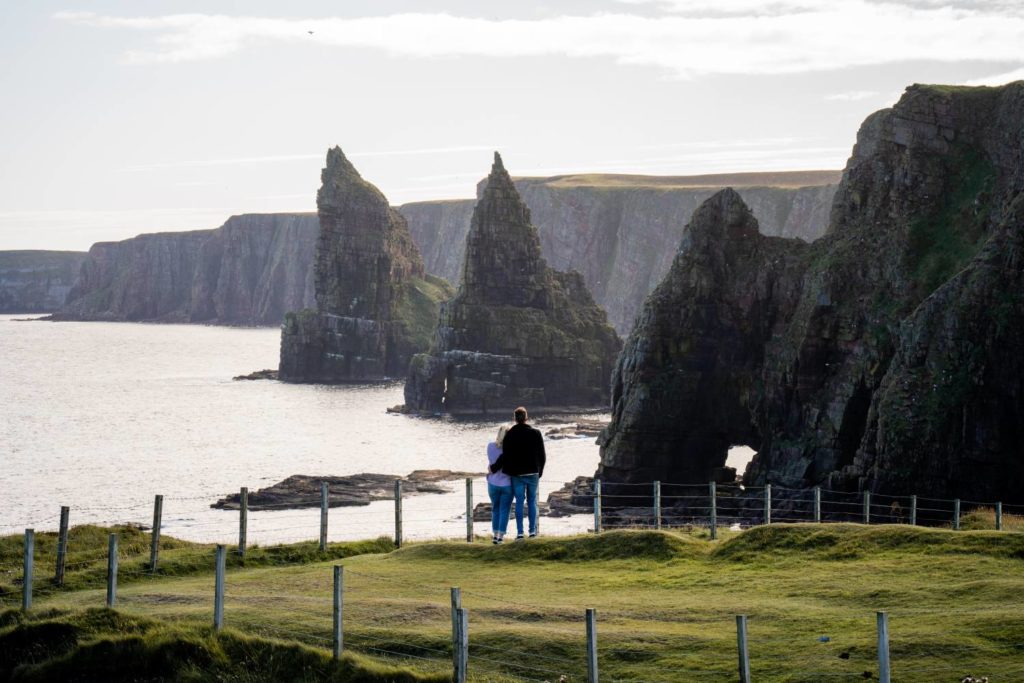
Discover the Hidden Coldbackie Sands
As you approach the small village of Tongue, keep an eye on the coast to your right. A glimmer of golden sands will appear far below, hidden behind the bushes that line the road. This secret paradise is known as Coldbackie Beach and is one of the most spectacular beaches on the NC500.
A layby at the side of the road will allow you to park up and begin the steep descent down towards the beach. This is quite a tricky climb, especially when the ground is wet underfoot, so take care and wear good shoes. Upon reaching the beach, take a moment to appreciate the seclusion around you and stretch your legs along the shore.
This is one of the most beautiful beaches we found on the NC500 and is definitely worth a visit.
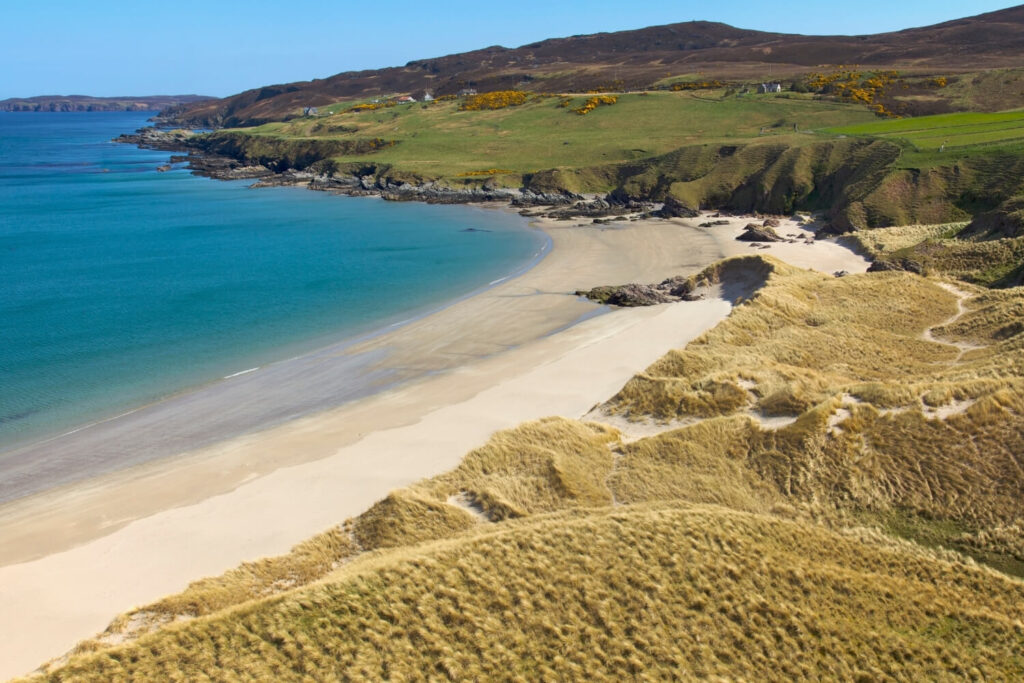
Take a Boat Trip through Smoo Cave
Just outside of the small town of Durness lies a cave that has a history dating all the way back to the Vikings. As you enter the 50ft opening to Smoo Cave (one of the largest Sea Cave entrances in the UK), you begin a journey through time back thousands of years.
Smoo Cave is one of the most fascinating stops you can make on the NC500 and is one we highly recommend. Inside the cave, you are able to board a small boat and enter deeper into the realms of the hidden world beneath the surface of Durness. Alongside a local tour guide, you can walk deep into the caves, hearing stories of how the Vikings used this area to store their boats from the stormy seas outside.
Thanks to the hard work of the locals, the cave network here is ever-expanding, with new caves being discovered every year. A lot of the cave openings are currently inaccessible due to being underwater, however, it is believed that during the time of the Vikings, the lower sea levels meant that the cave floor was actually about 10ft lower than it is today, giving access to the huge expanse underneath.
You can visit the Smoo Caves at any time of the day, with the main cave remaining open to the public 24-7. If you wish to explore deeper into the cave system, which is only accessible by boat, you will need to take part in an organised tour. The tour is subject to the local weather, as even a little rainfall can make the cave inaccessible. Due to this there are no advance bookings.
Read more about the cave tour and the work being done on Smoo Cave on their website here.
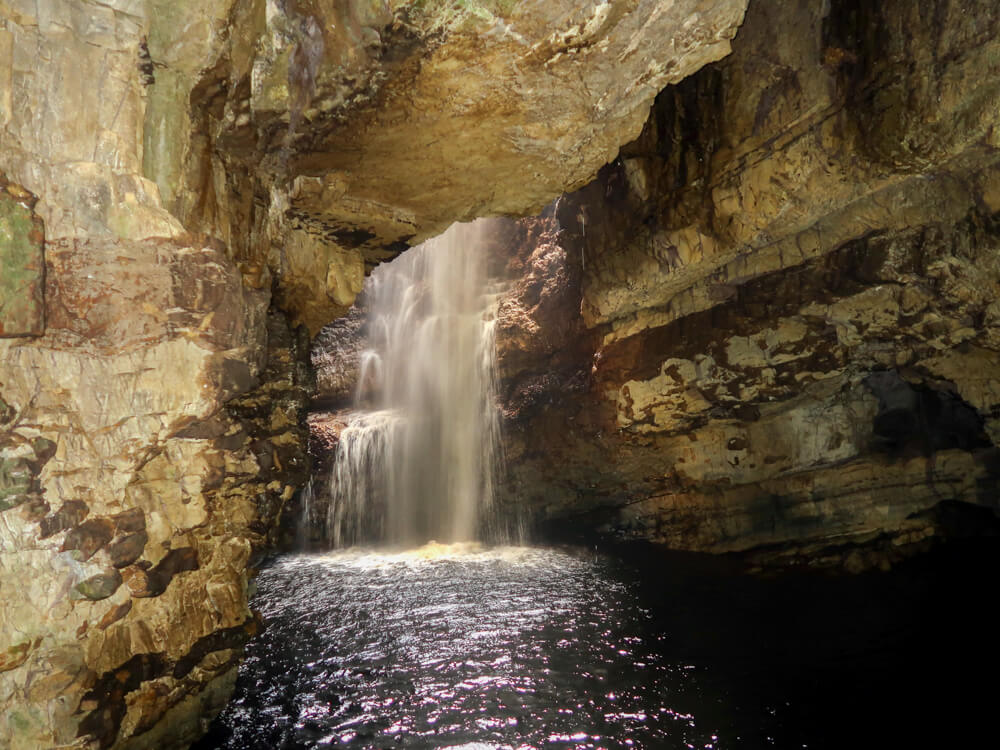
Catch an adrenaline rush at Golden Eagle Zipline, Durness
Have you ever been ziplining? Well now is your chance, and what better place to do it than on the most northerly zipline in Scotland. You’ll soar over one of the most beautiful white sandy beaches in Scotland and reach speeds of up to 40mph, flying across the beach at 37m high.
This activity is very much weather dependent so we would recommend keeping an eye on their Facebook page to check if they are running. No booking is required and the opening hours are between 10am-6pm.
During the peak season waiting times for the zipline can reach 3 hours so if it is something that you really want to do, make sure you get there early!
A new activity Golden Eagle have is the cliff jump. Are you daring to take matters into your own hands and jump from the cliffs overlooking Ceannabeinne Beach? The elasticated cord will catch you after a short free fall and gently lower you to the sand.
Cost – £15 per person.
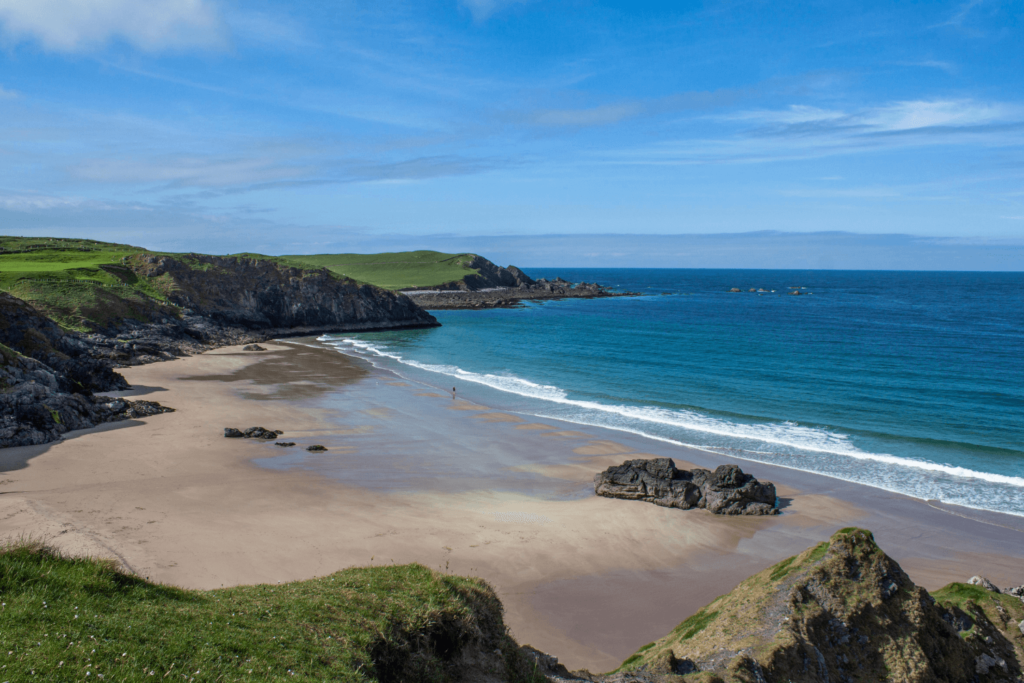
Stay near Sango Sands
Starting off the day in Durness, if you haven’t already paid a visit to the famous Sango Sands then now is the time to do it. If there is one thing about Scotland that takes most people by surprise, it is the number of stunning beaches that it has. Most of the pictures of the beaches along the northern coast of Scotland could be mistaken for the Caribbean, and Sango Sands is no exception.
This beautiful stretch of sand is overlooked by one of the best campsites on the NC500, Sango Sands Oasis, and is popular for wildlife watching and watersports. From the shores of Sango Sands, it is not uncommon to see seals, dolphins and even whales making their way along the coast.
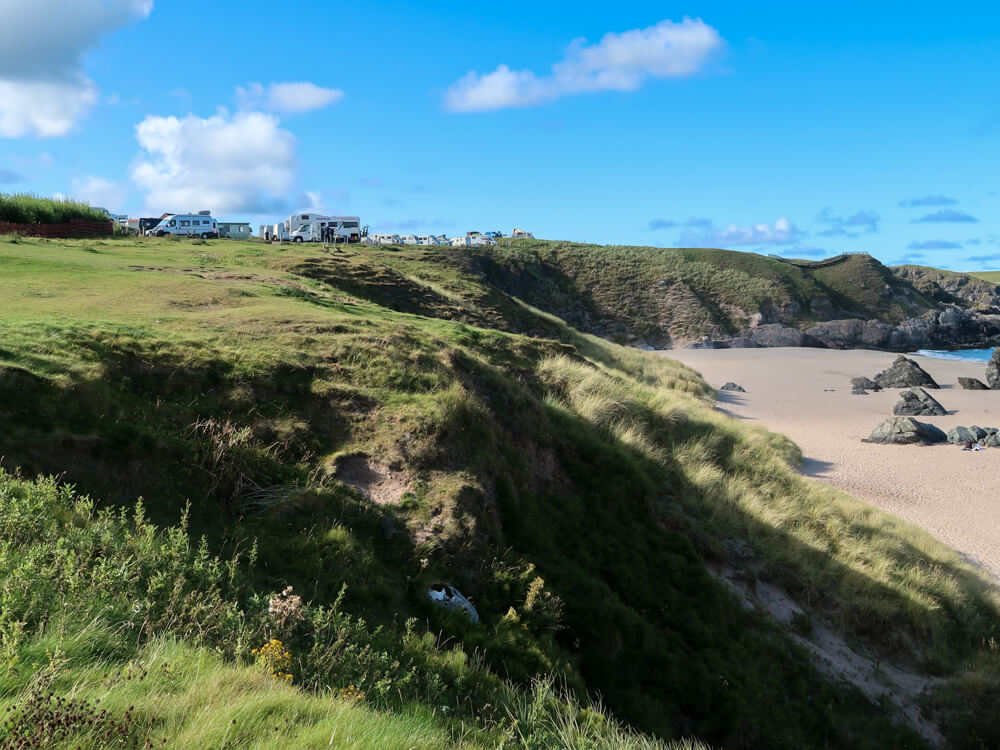
Visit the best chocolate cafe – Cocoa Mountain Cafe
There are two of these amazing cafes on the NC500 route, one in Dornoch and one in Durness. They serve delicious hot chocolate, cakes and homemade chocolate bars. Well worth a visit on route.

Take a Boat Trip to Handa Island
The remote Handa Island is one of the best day trips that you can take on the NC500 route. The island is around 300 hectares in size and the highest point of over 120-metres. The island Scotland Wildlife Trust nature reserve, home to over 100,000 wild seabirds and a greatly significant area in terms of birdlife and marine vegetation.
It is possible to visit the island by catching a ferry from the local port across to the island, where you will be met by an RSPCA volunteer who will give you a quick induction to the island. These volunteers take turns to live on the island and study the local wildlife, and so they are able to provide great insight into what you can expect to see on the island. They will also warn you of where you are and are not allowed to go on the island, depending on the breeding season. The island itself is quite small, with a walking loop around the entire island taking only a few hours. The walk around the island is absolutely breathtaking, made even better by the stunning views of mainland Scotland across the light blue water. Keep an eye out for dolphins and whales off the shore and as you make your way across to the island by boat.
The small, ribbed boat from Tarbet across to the island, normally runs between April to September. The furry runs six days a week, with no service on Sundays, and is of course art the discretion of the captain based on weather conditions. If you wish to know more about the ferry, you can find contact details on the website.

Marvel at the Kylesku Bridge
Driving south from Scourie, you will eventually reach the prominent construction of Kylesku, a contrasting sight against the rugged background of the Scottish highlands. This modern-looking bridge is famous for its sleek and beautiful design, which stands defiant against the breathtaking landscape of the North Coast 500.
This is not a culturally significant stop on the NC500, however, it is a worthwhile one nonetheless and is a definite photo stop.
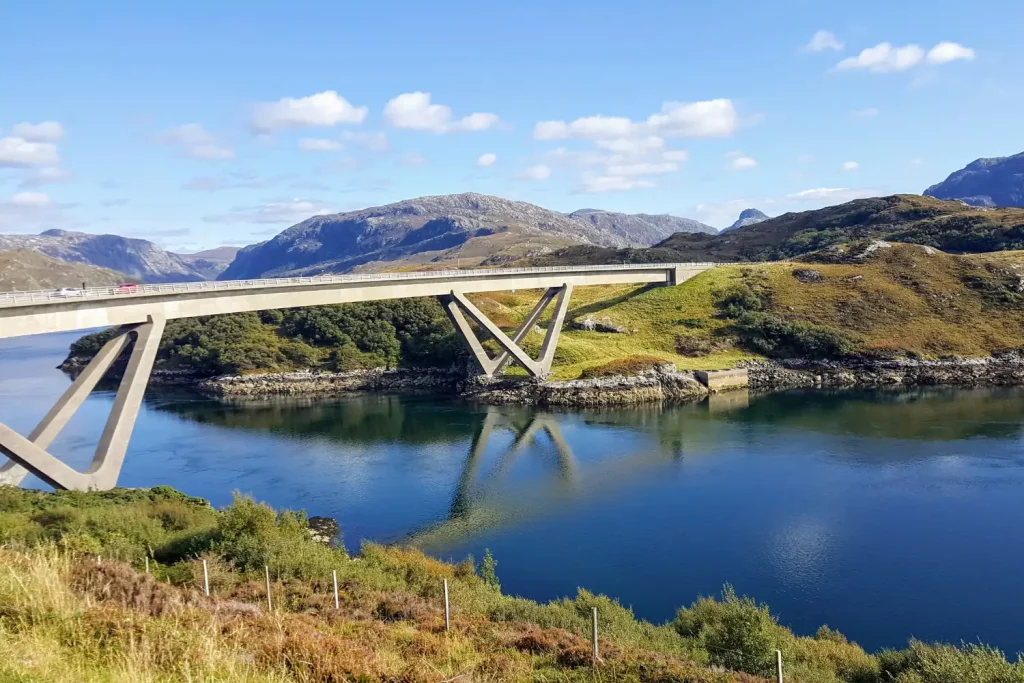
Visit the ruins of Castle Sinclair and Girnigo
The history and splendour of the castles around the NC500 are simply fascinating, none more so than the ancient remains of Castle Sinclair and Girnigoe. By far our favourite castle around the North Coast 500, these silent remains tell a beautiful tale of how life in the north of Scotland used to be.
Perched perilously close to the cliff edges, just north of the town of Wick, these beautiful castle remains look like they are straight out of a fantasy film. The castle itself has had quite an eventful history, including multiple seiges, grand expansions, and family murder. The earliest parts of the castle are believed to date back to the 15th century, with expansion projects being continuously added all through to the siege of 1680, which damaged the castle so badly it was never inhabited again.
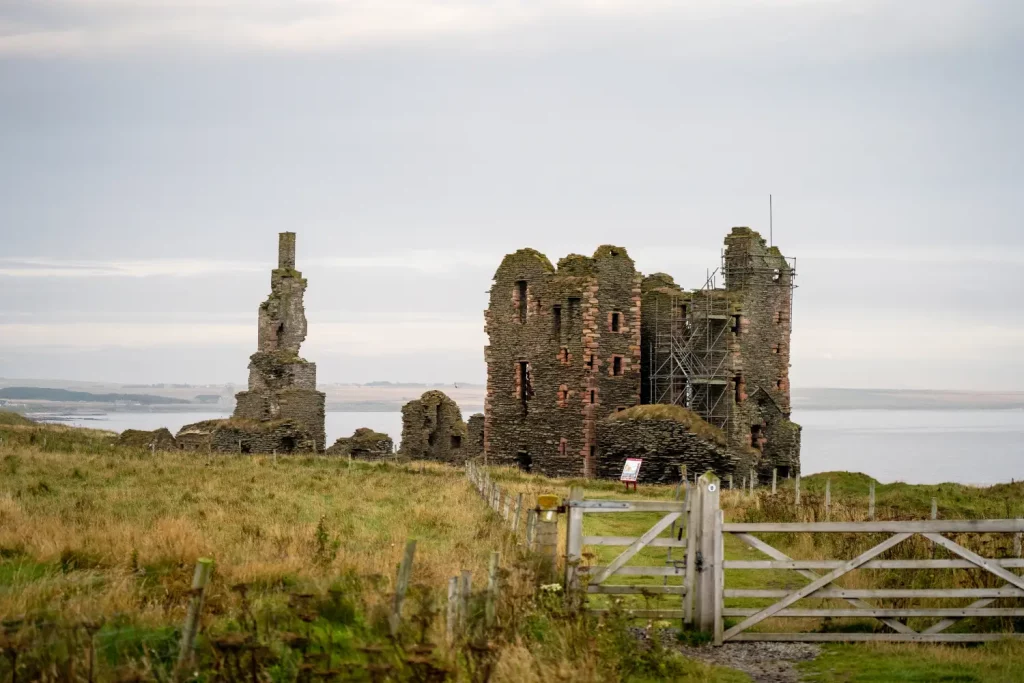
For the next 340 years, the castle remains slowly fell into decay until the beginning of the 21st century, when the Clan Sinclair Trust was formed in order to restore sites like this to a safe standard for visitors. The magnificent work these volunteers do can be seen all across the country, including the newly installed bridge access to the castle ruins of Sinclair and Girnigoe.
Upon your visit to this site, it is asked that you leave a small donation for the continual maintenance and restoration of projects such as this across Scotland.
The castle grounds are open year-round and are on a donation basis only.
Read more about the castles of Scotland in our full guide to the best castles on the NC500.
DON’T FORGET
Your trip to Scotland will be a lot more comfortable with a midge net and midge spray. These little biting bugs can be enough to ruin a trip if you don’t have the equipment to protect yourself from them. A repelling candle can also be helpful if you are sitting oustide.
Drive Britain’s Highest Road – The Bealach na Ba
There are two ways to reach the small village of Applecross, one leading around the peninsula to the north and one snaking its way directly over the mountains. If you are driving a large vehicle or are not comfortable driving on narrow, winding roads with steep drops, then I suggest you take the scenic route to the north.
The Bealach na Ba is one of the world’s most spectacular drives. It sits as the third highest road in Scotland and has the steepest ascent of any road in the UK, reaching an altitude of 626 metres. Named “the pass of the cattle“, the Bealach na Ba was once the only route from Applecross to the rest of the country and was used by farmers to transport livestock to the markets in central Scotland.
Today it is famous for its narrow, twisting turns, similar to those in the Italian Alps, as well as its stunning view of the sea from its highest point. On a clear day, it is possible to see all the way to the Isle of Skye and the beautifully haunting outline of the Cullin mountain range.

Scotlands most beautiful beach? – Achmelvich Beach
A beautiful white sandy beach with crystal clear water, what more could you want? Well.. maybe the water being a tad warmer! Achmelvich Beach is located near Lochinver in Sutherland on the west coast of Scotland. When the weather is nice, this beach is comparable to what you would see in the Caribbean. Don’t forget your camera!
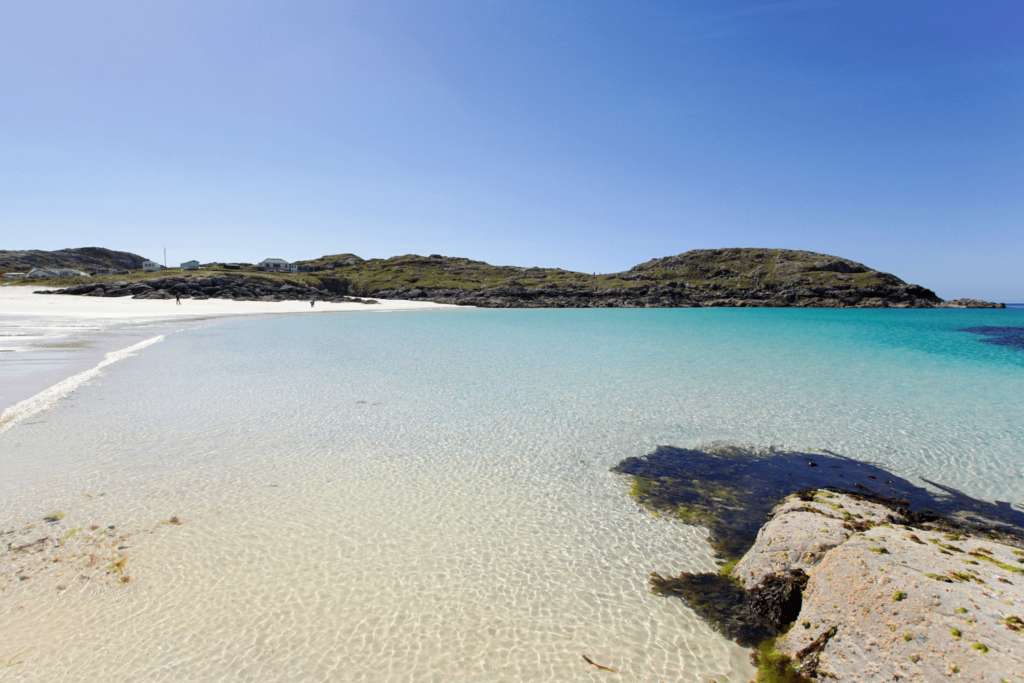
We would highly recommend getting yourself a Seashell dryrobe for keeping warm when you get out of the icy cold water! They even have pockets to store your keys!

Reach the top at John O’Groats
The most famous sight in the northern coast of Scotland and end of the countrywide, 874-mile trail from Lands End to John O’ Groats is the famous landmark signpost marking the end of the road. This signpost is one of the most photographed signposts in the world and draws thousands of visitors every single year, all eager to capture a picture at the edge of the world.
The sign that you visit today is actually a replacement of the original, which was installed in 1964 on private land and required a fee to have a photo taken beside it. In 2013 the original site was bought as part of a hotel renovation project, and upon completion, a new sign was installed in the original location available to public access.
If you wish to view the original and have your picture taken with customisable text on the sign, you can do so at the John O’Groats Caravan Park 180m from the original site.

Struggling to plan your North Coast 500 road trip?!
See the Dolphins at Chanonry Point
Just to the north of Inverness, slightly off track and definitely off the beaten path, the small peninsula known as Chanonry Point is the best place in the Moray Firth for dolphin spotting.
If you want to get even closer to these magnificent creatures, there are a number of dolphin tours available from Inverness, including the Dolphin Spirit tours that leave from the north of the city on the east bank of the river. One of the best things to do in Inverness.
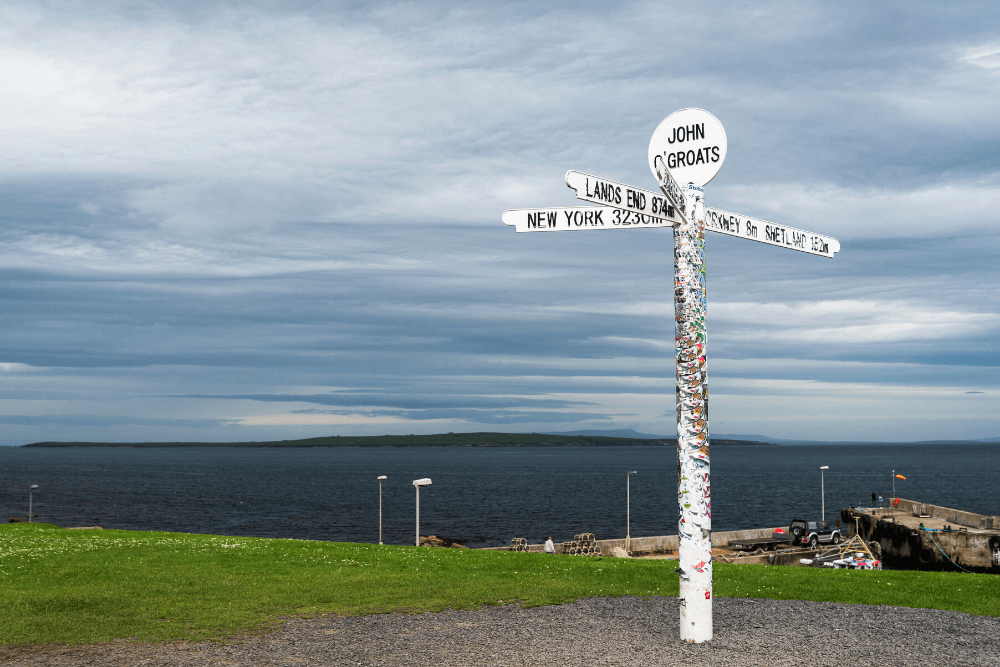
Destination North Coast Map
Make sure you have all the resources you need to make the most of your trip to the North Coast of Scotland. Our Destination North Coast Map is the perfect addition to any traveller’s toolkit. With detailed information on all the best spots, along the NC500, this map is your ultimate guide to exploring the rugged beauty of Scotland’s north coast.

Before You Leave on the North Coast 500
Before you head off on your trip around the NC500, there are certain things you will need to get organised to ensure a smooth trip. These include how to get around the route, including being aware of single track roads, etc., what to pack for Scotland, where to stay along the route and what travel insurance to book.
How Do I Get Around?
Given the remote location of the NC500 and the majority of the sights along the route, the best way to get around this road trip is by driving. There are of course other methods that are still popular, such as cycling and hiking, however, if you have a short amount of time on the route, neither of these are very suitable.
As for public transport, the use around the NC500 is understandably difficult due to how remote each location is, however, with the increasing problem of congestion along the route, this is a good option to research if you have time. If it is something that interests you, you can read a public formed itinerary of how to get around the NC500 by public transport over here.
If you are looking to rent a cosy, reliable and luxurious campervan for your trip along the NC500, we recommend hiring through Spaceships
Browse the full range of vehicles on offer at Spaceships over here.

Where to Stay on the NC500
There is a wide range of accommodations around the NC500 route, so you will not be short on options. Depending on how long you are spending in each area will depend on how long you spend in that location. It is worth bearing in mind that some accommodations will require you to stay a minimum number of nights so it is worth researching this when you are planning your North Coast 500 itinerary.
Our new book North Coast 500 Where to Eat and Stay shares the best places to eat and stay around the NC500 and includes whether places are dog friendly, accessible, have wifi and EVC ad whether they cater to dietry requirements.
The remoteness in the highlands of Scotland will leave you with little choice of accommodation in each location along the NC500, however, there are still enough options to choose from to ensure a comfortable trip. These are mostly in the shape of B&Bs, Airbnbs, converted cottages and other quirky accommodations.
Depending on how adventurous you are, there may be more accommodation choices than just the above, often with an even better view. Caravan and camping sites are abundant along the NC500, drawing camping enthusiasts from all over the world. For some of the most spectacular bedside scenery along the North Coast 500, we recommend packing a tent and getting in touch with nature for the week.
As we travelled along the North Coast 500, camped in our trusty Vango tent on a mixture of campsites and wild sites. Wild camping is a fantastic way to enjoy the beauty of the highlands, however, it must be done respectfully. Read our full guide to Wild Camping if you wish to give it a go so you know everything you need to for a comfortable and sustainable trip.
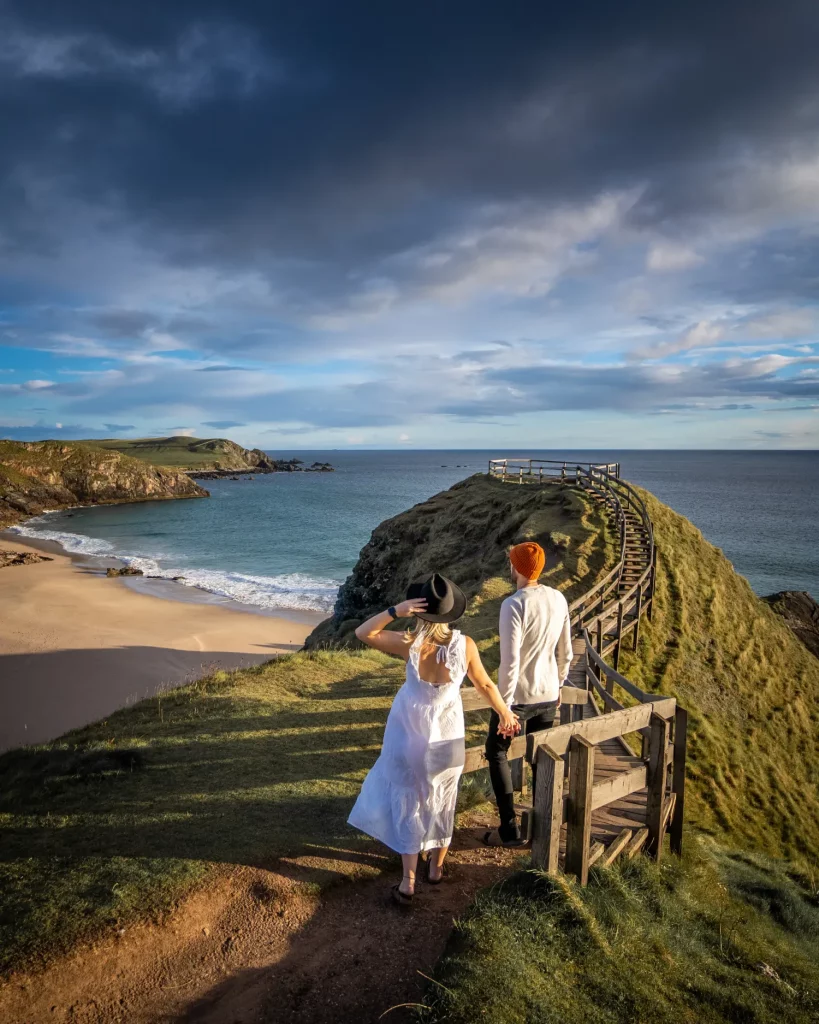
What Should I Pack?
When it comes to packing for a trip to Scotland there is one item of clothing that you are going to need all year round: a waterproof. It rains in Scotland on average 250 days a year, meaning that during your 5-day Heart 200 road trip you will probably experience at least a drizzle of rain. Due to this, the number one item on any Scotland packing list is a good waterproof jacket.
As for the rest of the year, the temperature in Scotland and the central heartlands is reasonably mild for most of the year. During the winter months, you will most likely experience snow, however, temperatures usually sit around freezing, so it is not too cold. For your reference, the average temperatures in Scotland are listed below during each season.
Spring (March, April, May) – 5-10 degrees C
Summer (June, July, August) – 15 degrees C
Autumn (September, October, November) – 5-10 degrees C
Winter (December, January, February) – 0-5 degrees C
As you can see, the weather never really gets above the teens, with anything over 25 degrees C considered a heatwave. The best way to pack for your trip to the highlands is with layers that can be added and removed as you need them. You will definitely need a hat and gloves during the colder months and will most likely need sunscreen to protect you on the long days in the open.
It is also important to stay hydrated, especially when you are out exploring in the marvellous landscape of Scotland. We use Water to Go water bottles to fill up with water from running streams when we are hiking.
We would also recommend taking our NC500 guidebooks with you on your journey. This will help you plan your itinerary and ensure that you don’t miss out on any of the best places to go on the NC500. Our Destination NC500 guidebook is well paired with NC500 Where to Eat and Stay and you can buy the combo here.
Given the beautiful sights and scenery that you are no doubt going to see around Scotland, we highly recommend packing a good camera for your trip. If you want to read more about the cameras we use and why we love them, check out the link below.
Photography Equipment
Main Photography Camera – Sony A7v Mirrorless Camera and Sony A7iii Mirrorless Camera
Microphone – Sony Mic ECM-B1M
Main Lens – Tamron 17-28mm f/2.8
Zoom Lens – Tamron 70-180mm f/2.8
Camera Tripod – ZOMEI Z669C Camera Tripod
Gorilla Pod – JOBY JB01507-BWW GorillaPod
Action Camera – GoPro Hero 11 and Insta 360 One RS
Drone Camera – DJI Mavic Pro 3
Camera Bag – Wandrd PRVKE 41L and The Nest by Tropicfeel
Phone Tripod – Manfrotto MKPIXICLAMP-BK, Mini Tripod with Universal Smartphone Clamp
Sturdy Phone Tripod & Selfie Stick – ATUMTEK 61″ Selfie Stick Tripod, Sturdy Phone Tripod Stand with Wireless Remote
Hard Drives – LaCie Rugged Mini, 5TB, 2.5″, Portable External Hard Drive
SSD – SanDisk Extreme Pro 1TB Portable NVMe SSD
Travel Adapter –Worldwide Travel Adapter Universal Travel Plug with 4 USB Ports+Universal AC Socke
What is the Best Travel Insurance for the North Coast 500
I know travel insurance is the least enjoyable thing to purchase and look at when you’re planning a trip, however, you wouldn’t want to be without it in the event that something happened. Accidents can happen anywhere and the extortionate medical bills will ruin your trip if you are not covered.
To ensure you have a stress-free trip with no worries about potential medical bills, make sure you cover yourself when you travel. We can recommend using SafetyWing, a backpacker-friendly and cheap insurance company that provides good coverage and support. It is also nomad-friendly, unlike most other insurance companies, meaning you do not need to worry about being out of your home country for too long.
Get a quote for your travel insurance right here and get covered!
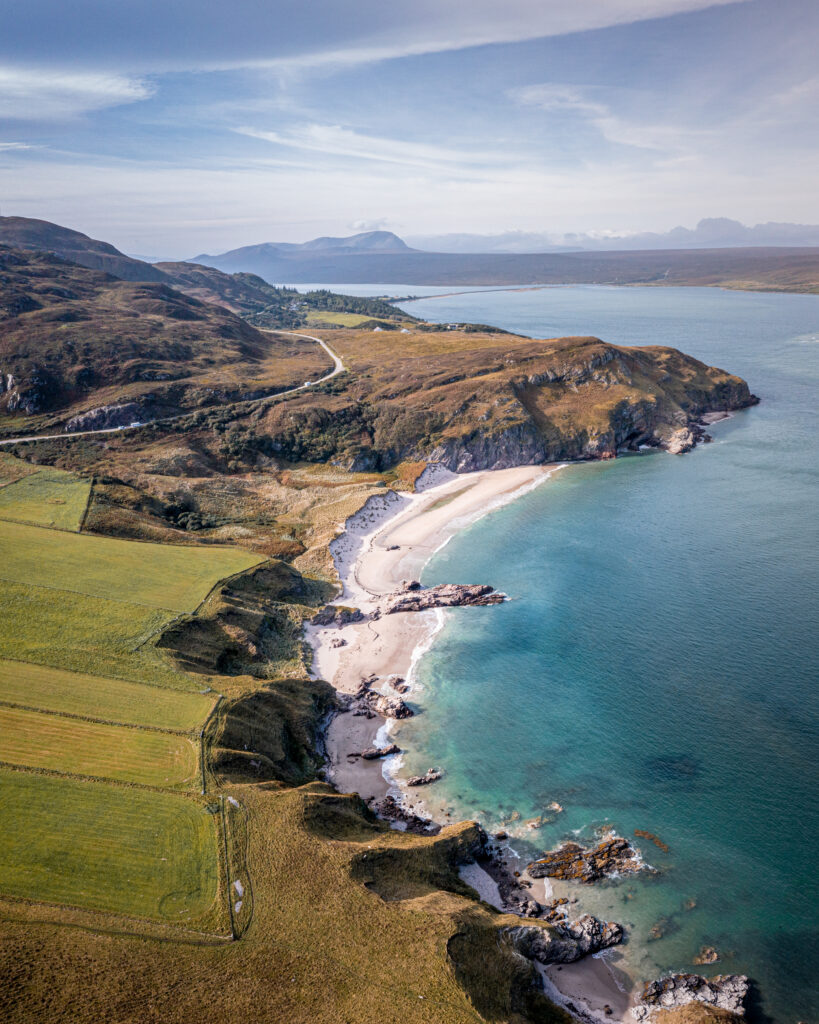
So there you have it, all of the best things to do along the North Coast 500, including castles, cliff views, and beaches. If you have visited the NC500 recently, let us know what you thought of the sights listed above, or if you have any suggestions let us know in the comments below.
As always, sharing is caring so make sure to share this photo guide with your family and friends and inspire them to head off on their own North Coast 500 adventure. If you are planning the trip for yourself, make sure you have a look at the rest of our Scotland content for more inspiration to our beautiful home country.
When you set off on your own adventure, be sure to tag us in your photos on Instagram and we will share them with the rest of our community. In the meantime, why not follow us over there to see what we are currently up to and keep up with us on our Instagram Stories.
Now Read:
This article may contain affiliate links that provide us with a small income. For more information read our Affiliate page.
Pin it for later!
